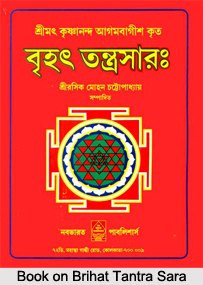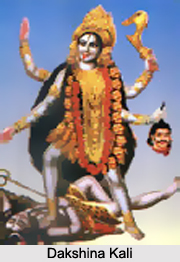 The Tantric texts of Bengal had an all-encompassing sway due to which some Bengali scholars had started writing Tantric works. As far as Buddhist Tantras of Bengal are concerned many of them exist in their Tibetan and Chinese versions. The Sanskrit works have been lost. However the earliest Hindu Tantra dates back to the fourteenth century A.D. A significant feature of Hindu Tantra of Bengal is that it belongs to Kalkula.
The Tantric texts of Bengal had an all-encompassing sway due to which some Bengali scholars had started writing Tantric works. As far as Buddhist Tantras of Bengal are concerned many of them exist in their Tibetan and Chinese versions. The Sanskrit works have been lost. However the earliest Hindu Tantra dates back to the fourteenth century A.D. A significant feature of Hindu Tantra of Bengal is that it belongs to Kalkula.
The followers of Kalkula have an idealistic outlook. They believe in the identity of Shakti and Brahman in its three aspects of that which exists, consciousness and bliss. Sakti is not a separate unit. According to them Siva-Sakti is a concept which is beyond dualism and can be realised only through experience. The Bengal school of Tantra is more concerned with the Karma Kanda of Tantra. Bengal Tantra is ritualistic in nature. Many are shortcuts and a larger number of works are priestly manuals which are designed to facilitate the performance of Tantric rituals. Tantric studies were persistent till the 19th century. The early years of the present century witnessed creation of some Tantric manuals.
Buddhist Tantra of Bengal appears to have originated in the first half of the seventh century A.D. Buddhist Tantra of Bengal does not recognise Shaktism. They recognise one male principle and one female which underlie everything. Buddha Tantra recognises Upaya-Prajna to which has the same function as of Siva-Sakti but in a reverse order. The Buddhists advocate the idea of Sunyata. According to this philosophy one should not fix one`s mind on higher objects. One must learn to live in a state in which there is neither space nor time.
Some of the Hindu Tantras try to show that they are based on the Veda thereby quoting Vedic mantras. However Buddhist Tantras do not consider Veda as a reliable source. Buddhist Tantras look upon gods as conceptual entities which exists only in the worshipper`s mind. Buddhism rejects aesthetic imagery however they recognise the inner `god`. Buddhist Tantra recognises a set of energy-fields which is inherent in the body.
However both Hindu and Buddhist Tantras have two aspects - philosophical and the popular. Hindu Tantras are dialogues between Siva and Parvati. Mantra is given great importance. Mandala and Mudra play an important role in both the types of texts of Tantra.
 The Buddhist works do not recognise Kundalini instead they mention a female energy which has the force of fire. The topics dealt with in Buddhist Tantra are: Nature of Kula, male principle and female principle, creation and dissolution, Bindu, Kala, Moksa or Nirvana, Siddhi, Yoga, Sahaja-Tattvas.
The Buddhist works do not recognise Kundalini instead they mention a female energy which has the force of fire. The topics dealt with in Buddhist Tantra are: Nature of Kula, male principle and female principle, creation and dissolution, Bindu, Kala, Moksa or Nirvana, Siddhi, Yoga, Sahaja-Tattvas.
Mahamahopadhyaya Parivrajakacharya is the earliest Bengal writer on Hindu Tantra. This work describes the diagrams which are used in Tantric rites. Sarvananda is an outstanding figure among the Tantric Sadhakas of Bengal. His son, Sivanatha, appears to have written his biography which is entitled Sarvananda-Tarangini.
The Sarvollasa is a compilation that deals with Tantric Sadhana in general and Virasadhana meticulously. Raghu Natha Tarkavagisa Bhattacharya was a scion of the renowned family of the Bengali Sakta devotee, Sarvananda. The Agama-tattva-vitasa is a huge work in five lengthy chapters which sets forth the essence of a large number of works like Veda, Purana, Tantra, astronomical and Smrti-sastra. The Radha-tantra of unknown authorship may have been of Bengal origin. In this Krishna has been represented as a worshipper of Sakti and his life symbolises the worship of Sakti.
In the nineteenth century Tantric ideas was visible in Bengali poems, Baul songs and Sakta devotional songs. Haragovinda Raya had compiled a huge Tantra in the first quarter of the nineteenth century in Bengal. The work was entitled Pahcama-veda-sara-nirnaya is divided into six sections which is divided into sub-sections. The work deals with the worship of Daksina Kalika and Kula rites. Amara Maitra in the second quarter of the nineteenth century composed three Tantras on Tantric Sadhana and Yoga. Durgarama by Durgarama Siddhantavagisa was published in Kolkata in 1891 and translated too.




















